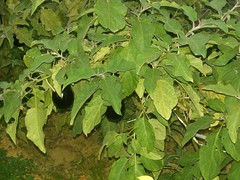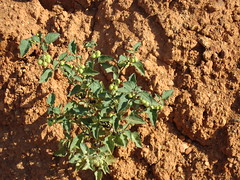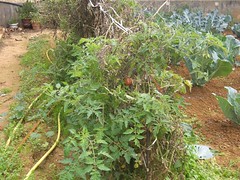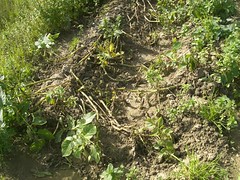Pomodoro! by David Gentilcore
The history of the tomato could be described as saucy, just like its use. We learn from Pomodoro! that it started off being considered a poisonous plant, related to two other equally unpopular plants in antiquity: the tomato, the eggplant and deadly nightshade are all part of the Solanum family of plants. Eggplant and tomato are now eaten all over the world, as is the potato (another relative to the tomato), but deadly nightshade (Solanum nigrum) is known to very few, mainly Cretans like myself (we call it stifno), and people living on the Mediterranean coastline of Southern Turkey.
The tomato (below left) is closely related to the eggplant (above left), deadly nightshade (called stifno in Crete; above right), and - of all things - the potato (below right). One look at their leaves and the resemblance becomes more apparent!
Some trivia from Gentilcore's book: Tomato was regarded as poor man's food, not just because it couldn't provide nourishment in the way other crops like wheat did, but because tomato was a low-lying crop; the closer to the ground a crop lay, the more lowly its status! The book covers the tomato's career as it became an object of scientific interest, eventually being regarded as an exotic garden species by the rich, before gaining its reputation as the most important global non-grain crop, with Italy being "Europe's premier tomato nation". The book also contains some of the earliest known Italian tomato recipes, which unsurprisingly are still being used in slight variations following the technological innovations of modern times (eg the grater, the food processor, a greater range of spices available almost everywhere, etc). Some sad truths about tomato production are touched on in the epilogue, from the import of tomatos from China to Italy while local tomatos were left rotting in the Italian countryside, to the attempts to genetically modify tomato, which "turned out to be a dud".
*** *** ***
Here's a slightly sharp-tasting sauce that combines tomato and olive oil with some herbs and spices, to make a great dip for thickly sliced sourdough bread. It can be used for a topping on rusk or toast. This kind of dip is commonly eaten in Crete right throughout the open-air growing season for tomato. A freshly grated tomato over a slice of bread or rusk was a popular snack (until globalisation got its way and changed people's dietary habits). The tomato season in Crete is longer than other Greek regions, given the extended sunny period that Crete enjoys. We can enjoy the taste of garden fresh tomato grown in the open field for at least six months. It is most unusual for me to cook something without the use of tomato in some way. Tomato doesn't usually play a prominent role in our meal; it is nearly always a highly essential ingredient in my cooking, playing a background role. It is rarely referred to in the name of the dishes I cook, but its absence would be blatantly obvious. Because tomato is such an important ingredient in my family's food, just like David Gentilcore's mother, I make a lot of home-made tomato sauce for use in the winter; tomato is a staple in the Cretan kitchen
You need:
1 large tomato, grated
1-2 cloves of garlic, according to taste
olive oil
salt and oregano for seasoning
Drain the grated tomato of its excess liquids. Add the salt to the grated tomato, and let stand in a fine sieve until more liquids drain away. Chop the garlic finely and add this with the oregano to the strained tomato in a small wide bowl. Drizzle some olive oil over the tomato. Use this dip with slices of fresh sourdough bread (optionally toasted), as a snack or a light meal, accompanied by some cheese.
If you don't want to go through so much processing, why not just enjoy tomato straight off the plant, just like my daughter!






Thanks to Rachel, the Crispy Cook, for the chance to review Pomodoro!: A History of the Tomato in Italy (Arts and Traditions of the Table: Perspectives on Culinary History)
©All Rights Reserved/Organically cooked. No part of this blog may be reproduced and/or copied by any means without prior consent from Maria Verivaki.





As with the Potato - can we imagine European cuisine without it? But it is such a recent entry into European diets.
ReplyDeleteThis looks like what we ate in Spain almost every day! If it is made with good quality tomatoes it is one of the tastiest things summer has to offer. I really enjoyed the book, will be posting soon.
ReplyDeleteSuch a glorious way to enjoy tomatoes. I feel for you over the bottle that slipped and smashed - I will be trying the sensible method of grating tomatoes over our next summer, it will remove all the bist that are difficult for surgically shortened digestive innards.
ReplyDeleteYou have such a wonderful veggie garden - congratulations to your husband for the produce and to yourself for the beautiful and favoursome food you make.
Sending care and huggles from a very windy Wellington (a sure sign of Springtime!!!) We are okay and safe here, Canterbury has taken a battering but thankfully no lives were lost.
Michelle and Zebbycat, xxx and purrrrubles
Great book commentary. And I agree that the best tomato recipes are the simplest ones that accentuate the tomato's wonderful flavor and perfume. Glad you enjoyed the book!
ReplyDeleteI am headed to the kitchen now to give it a try since I have all of the ingredients.
ReplyDeleteInteresting. Sorry about your jar. Maybe someone you know has a surplus? And why didn't the tomatoes grow this year?
ReplyDeleteIt's incredibly wet here, huge amounts of rain.
Your recipe and the foto look delicious, but it's suddenly so cold and autumn-like that i don't feel so much like eating summer food, i think.
I learned about grating tomotoes from a tv programme about greek cooking, but usually i just make chunks. Draining the fluid is new to me, i will certainly try it. (Waiting for something like summer to return for a bit.)